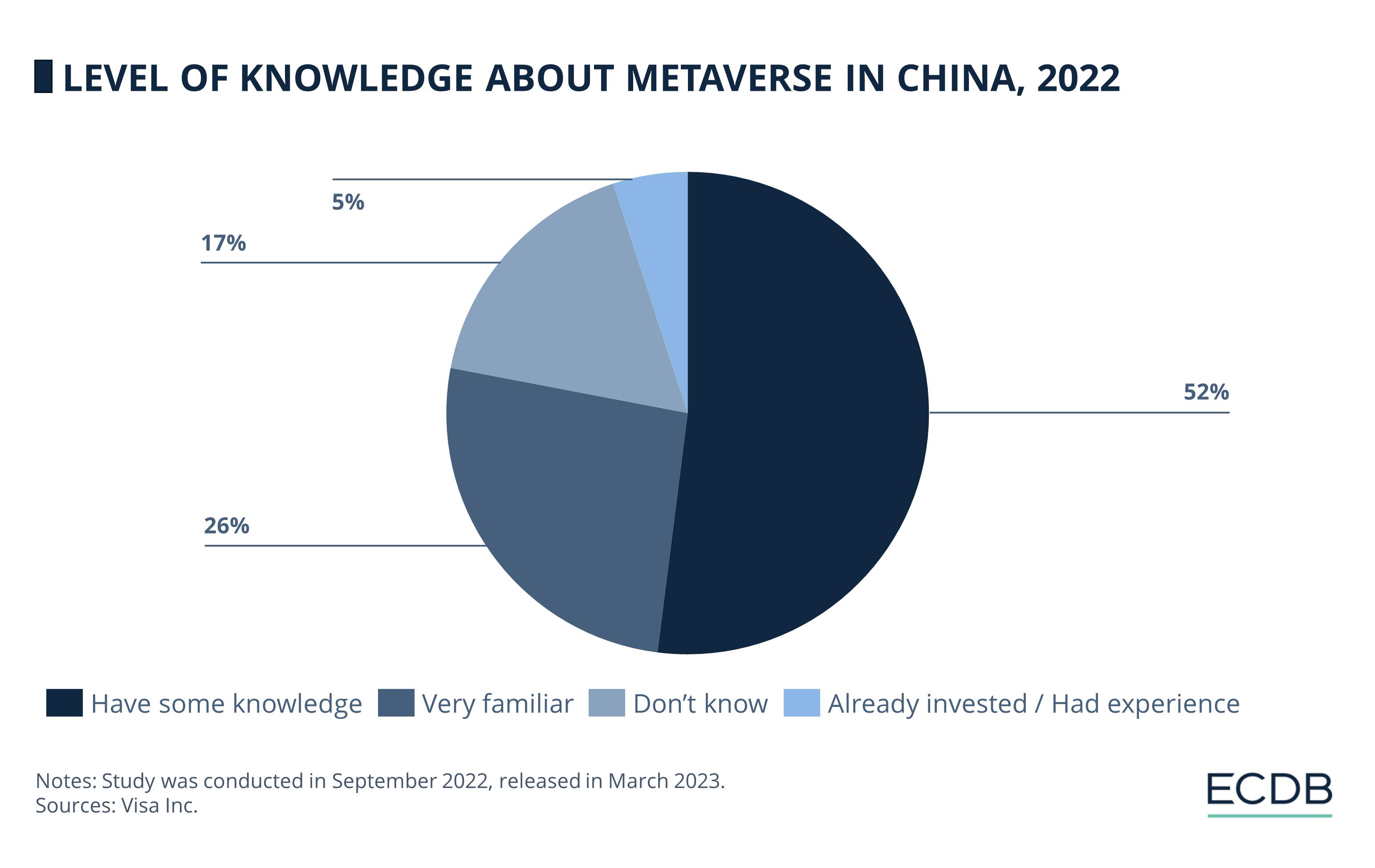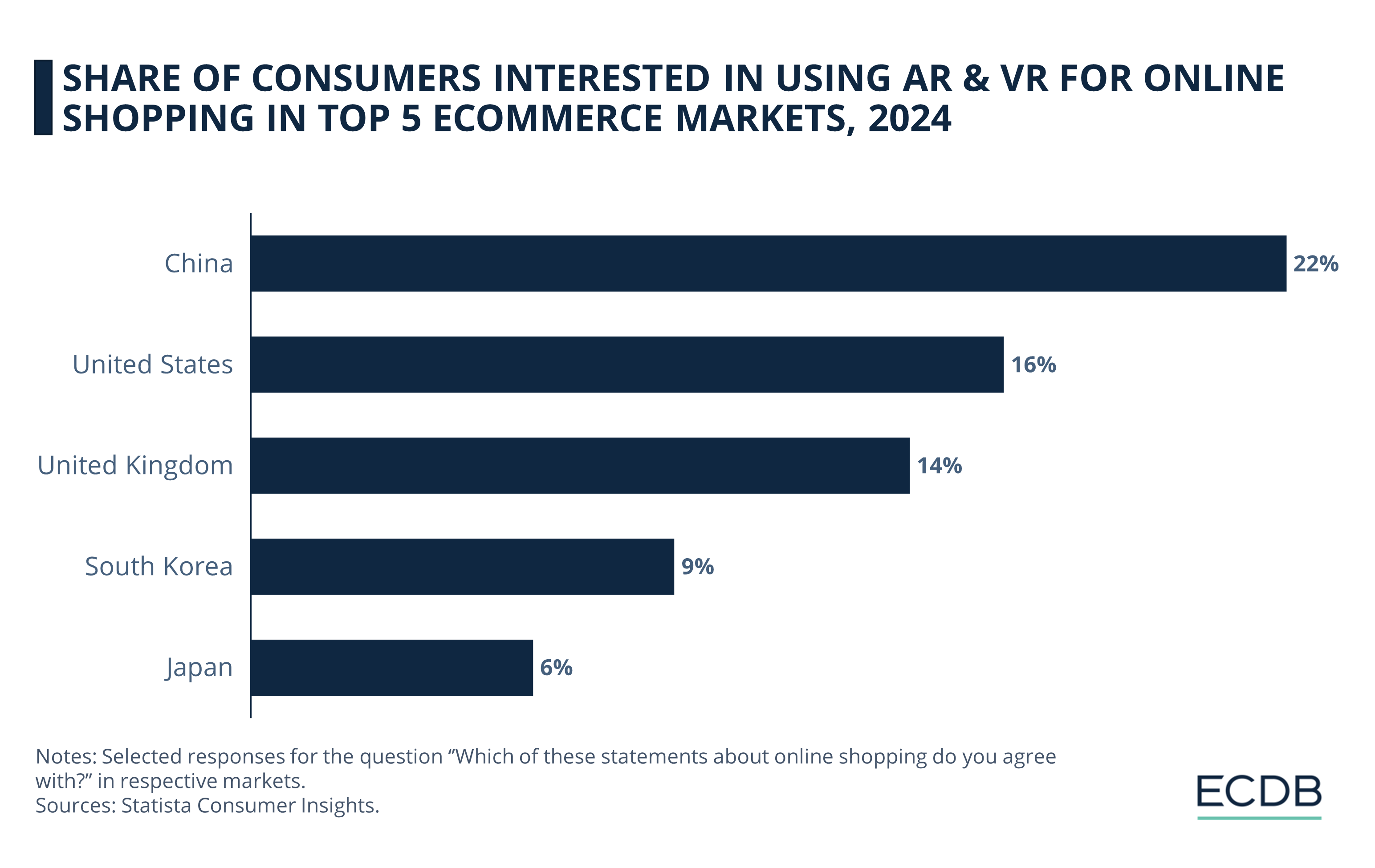eCommerce: Metaverse
Metaverse in China: Transforming the Future of eCommerce
How is Metaverse faring in the world's largest eCommerce market? Find out how this technology is perceived in the country and how it's being adopted.
Article by Cihan Uzunoglu | June 17, 2024Download
Coming soon
Share

Metaverse in China: Key Insights
Metaverse Familiarity: A study shows that while only 5% of Chinese respondents have invested in the Metaverse, 26% are very familiar with it, and over half have some knowledge, highlighting significant engagement and interest in this expanding digital domain.
Enhanced Engagement: Virtual shopping in the Metaverse significantly enhances customer engagement, with users spending seven times more time in 3D shopping environments, leading to a 70% increase in conversion rates and a 450% surge in ROI for retailers.
AR Integration: Augmented Reality (AR) enhances the Metaverse by integrating digital and physical worlds, significantly boosting immersive shopping experiences, with China leading in consumer usage for AR and VR in online shopping at 22%.
AR Challenges: While AR enhances the Metaverse shopping experience, it still faces challenges in replicating the "true fit" for clothes, highlighting the need for further evolution or niche applications, as China focuses on using the Metaverse to support industrial and economic objectives through government-backed initiatives like the Three-Year Action Plan.
The Metaverse, a captivating digital domain, is increasingly influencing the eCommerce landscape in China. A recent IPSOS survey regarding extended reality (XR) — a comprehensive phrase that encompasses augmented reality (AR), virtual reality (VR), and mixed reality (MR) — found that a staggering 78% of Chinese citizens harbor a positive outlook towards XR. This figure surpasses the global average by 28%.
But what percentage of China is familiar with this new technological medium?
One Quarter of China is Very Familiar with
the Metaverse
As revealed by a study from Visa Inc., the level of familiarity and engagement with the Metaverse varies among Chinese respondents.

5% of respondents had already invested or had experience with the Metaverse,
26% were very familiar with it,
52% had some knowledge but not too much,
and 17% did not know about it at all.
Known for their zest for socializing, penchant for live streaming, and a keen disposition to embrace novelty, China's Gen Z is a natural fit for the Metaverse. The compelling allure of the Metaverse, a world popularized by the gaming industry, is not confined to this sector alone. Its scope has diversified to encompass fields such as fashion, advertising, tourism, and finance. In doing so, it has significantly redefined the shopping experience, making virtual shopping a burgeoning reality.
Discover Our Data: Our frequently updated rankings provide essential insights to help your business thrive. Wondering which stores and companies are excelling in eCommerce? Interested in the top-performing categories? Find the answers in our rankings for companies, stores, and marketplaces. Stay competitive with ECDB.
Higher Interactivity, Better Engagement
In the virtual shopping realm, customers enjoy the privilege of interacting with other shoppers and brand representatives from the cozy confines of their homes. They can even experiment with trying on products virtually. This dynamic approach to shopping paves the way for brands to amplify their engagement time with consumers.
In fact, it has been observed that consumers spend seven times more of their time immersed in a virtual 3D shopping experience than they would on a conventional static website. This was supported by a study from Daxue Consulting, which revealed that customers typically spend 14 minutes in a 3D shopping environment, compared to less than 2 minutes on a standard website. One should, however, keep in mind that the study lacks specific details on participant activities and does not prove long-term consumer enjoyment or preference for virtual 3D shopping experiences.

The remarkable appeal of this enhanced shopping experience is also evident in the increased conversion rates, which have spiked by an impressive 70%. Furthermore, the encouraging return on investment (ROI) statistics cannot be ignored. Retailers venturing into virtual shopping experiences have reported a monumental 450% surge in ROI — a clear indication of the overwhelmingly positive response from consumers.
Consequently, the immersive and unique nature of virtual shopping within the Metaverse is gaining widespread attention, offering intriguing possibilities for the future of retail in China.
Augmented Reality: Making Metaverse
a "Reality"
AR emerges as the catalyst that elevates the Metaverse's immersive nature, bringing the concept of a “mixed medium experience” to life. By seamlessly integrating the digital realm with our tangible world, AR forges a critical bridge linking the Metaverse with reality. In theory it plays an integral role in orchestrating an immersive shopping experience, allowing customers to engage with other shoppers, experiment with products, and arguably relish the thrill of a real-world shopping adventure.

Among the top 5 eCommerce markets worldwide:
China the highest share of consumers (22%) who are keen on using AR and VR for online shopping.
United States follows with 16%,
While 14% of consumers in the UK share the sentiment.
South Korea is at #4 with 9%,
And Japan rounds out the list at 6%.
In light of this burgeoning potential, companies like Kivisense have engineered innovative Web AR try-on solutions, a breakthrough that numerous enterprises have eagerly integrated into their websites. Renowned global brands such as Farfetch and Gucci have launched AR Clothing try-on facilities, harnessing this technology to animate their apparel along with the customer's movements. This delivers a realistic shopping encounter by transcending geographical barriers.
Other Side of the Medallion
With all these developments, the consumer world still remains in the experimental phase, familiarizing itself with virtual shopping. A key challenge is that AR has yet to accurately replicate the “true fit” of a product, crucial for clothes shopping. This speculation suggests AR may need to evolve further or find its niche in categories like jewelry, where fit is less important. While AR enhances the Metaverse shopping experience, its future depends on replicating traditional shopping aspects or capitalizing on its unique strengths.
Despite the promising developments, there are notable challenges and unique dynamics in China's Metaverse growth. The Chinese government shapes the Metaverse to support industrial and economic objectives. The Three-Year Action Plan for the Industrial Innovation and Development of the Metaverse (2023-2025) outlines China's vision to build industrial clusters around emerging technologies, integrating the Metaverse with traditional manufacturing sectors. This approach emphasizes advanced Metaverse technologies in industries like home appliances, automotive, and aerospace.

Chinese companies, influenced by government support, are focusing on industrial applications. For instance, Digitwin Technologies has shifted its focus to energy and manufacturing, aligning with the national agenda to boost industrial efficiency and innovation through the metaverse. This integration of digital and physical worlds aims to foster industrial progress, creating a unique Metaverse landscape in China that prioritizes economic growth alongside enhanced shopping experiences.
Metaverse in China: Final Thoughts
China's Metaverse landscape continues to evolve, driven by robust governmental support and technological innovation. With initiatives like the Three-Year Action Plan, China aims to integrate metaverse technologies into various sectors, from manufacturing to retail. This strategic approach ensures that the Metaverse not only enhances consumer experiences but also contributes to economic growth.
As companies and the government work together, China is poised to become a global leader in the Metaverse, showcasing how digital and physical worlds can seamlessly converge to create new opportunities and efficiencies.
Source: Daxue Consulting, iiMedia Research, Visa Inc., Taylor Wessing, Wired, Statista, ECDB

Click here for
more relevant insights from
our partner Mastercard.
Related insights
Deep Dive
American Apparel & Footwear Association (AAFA) Calls Out Social Commerce Platforms for Counterfeiting
American Apparel & Footwear Association (AAFA) Calls Out Social Commerce Platforms for Counterfeiting
Deep Dive
Shopify: The Globally Most Used Shop Software Is Growing High in Q2 2024
Shopify: The Globally Most Used Shop Software Is Growing High in Q2 2024
Deep Dive
Global Social Commerce Market: Top Platforms, Markets & Trends
Global Social Commerce Market: Top Platforms, Markets & Trends
Deep Dive
What Exactly Are In-Game or In-App Purchases?
What Exactly Are In-Game or In-App Purchases?
Deep Dive
AI in eCommerce: Better Deals, Greater Precision, and Easier Targeting
AI in eCommerce: Better Deals, Greater Precision, and Easier Targeting
Back to main topics